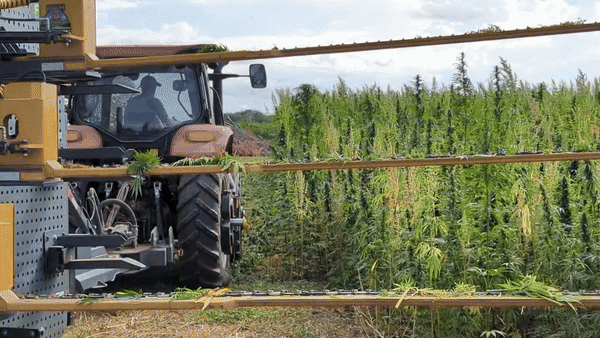WAKONDA, S.D. (KELO) — Fields of hemp 10-feet high were waving in the breeze Tuesday about a mile and a half west of Wakonda, South Dakota, waiting for John Peterson, CEO of Dakota Hemp, to pass through with his harvester.
The harvester in question is a specialty build from a company in Nebraska, built to cut 10+ foot stalks into quarters, but Peterson clarified that for many varieties of hemp, a regular combine can be used.

Peterson said this season — the 4th hemp growing season in South Dakota — started a bit late. “Due to wet field conditions,” Peterson said, “but once we got it into the ground, it really took off in the warm conditions.”
This year’s season began with planting in early June, and Peterson said he began his harvest in early September. This, he said, is one selling point for hemp.
“We’re usually done with our hemp harvest by the time we get into bean harvest,” he said, indicating that a producer could grow hemp alongside other crops without straining their schedule.
This is in part due to hemp’s short growing period of around 100 days. Peterson joked “if you switched all your crops over to hemp, you’d be able to spend all of October and November on the golf course.”
Peterson said the crop yield this year has been good. “We found that we can really grow very good hemp here,” he said. “We had very good grain yields, very good stock yields.”
Asked about the yield, Peterson said some of the taller varieties yield around 3-4 tons per acre, with prices around $300/ton. “So you’d be looking at $900 to $1200 per ton gross revenue off of those,” he said.
Derrick Dohmann with Horizon Hemp Seeds also spoke to KELOLAND News. He said seed comes from specific companies in the U.S., Europe and Canada, which can lead to some challenges when it comes to supply chain.
The biggest issues that Dohmann pointed out was the balancing act of buying enough seed to supply those who have contracted in advance, without having too much excess seed left over. Though this can be an issue with seed coming all the way across the Atlantic, Dohmann expects things to get simpler as domestic seed production ramps up.
Beyond seed access and growing, however, the most pressing issue at the moment is processing. Once the hemp is grown and harvested, it needs to be processed so it can become product.
Peterson and his COO Karll Lecher showcased some of these potential products, ranging from composite boards to pants and even pasta.

Currently, there is only one processor in the state of South Dakota, though Peterson expects to bring his own facility online in the near future.
“We’re going to be limited to our throughput capacity, which puts us at about 4000 acres per year in the state currently until we can get some more processing facilities to come online,” said Peterson.
Processing is expensive — Peterson compared the cost to start up a facility to roughly that of buying two new combine harvesters — but it does come with the promise of future demand for processing from the industry.
Peterson says that if people are interested in learning more about hemp production or processing, they can reach out to him at Dakota Hemp, or to the South Dakota Industrial Hemp Association.






